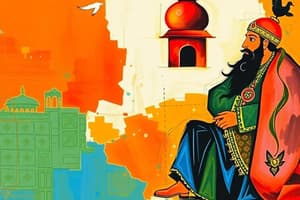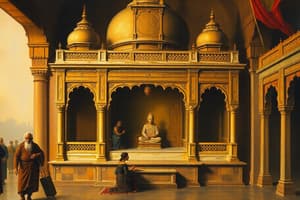Podcast
Questions and Answers
Who is considered an enlightened despot among the following emperors?
Who is considered an enlightened despot among the following emperors?
- Aurangzeb
- Akbar (correct)
- Sher Shah
- Babur
Which queen fought against Akbar?
Which queen fought against Akbar?
- Rani Padmini
- Durgavati (correct)
- Rani Lakshmibai
- Rani Durgavati
Which of the following rulers belonged to Bikaner?
Which of the following rulers belonged to Bikaner?
- Humayun
- Rao Chandrasen
- Raja Rai Singh (correct)
- Maharana Amar Singh
Which location is associated with the military campaigns in the context provided?
Which location is associated with the military campaigns in the context provided?
Who was the ruler connected with the conflict involving Akbar and Durgavati?
Who was the ruler connected with the conflict involving Akbar and Durgavati?
In which year was the Battle of Haldighati fought?
In which year was the Battle of Haldighati fought?
Who was the commander of Rana Pratap’s army in the Battle of Haldighati?
Who was the commander of Rana Pratap’s army in the Battle of Haldighati?
Which Rajputana state did not willingly accept the supremacy of Akbar?
Which Rajputana state did not willingly accept the supremacy of Akbar?
Which of the following Muslims rulers abolished the pilgrimage tax?
Which of the following Muslims rulers abolished the pilgrimage tax?
Who among the following Rajput rulers continued his struggle for independence against the Mughals?
Who among the following Rajput rulers continued his struggle for independence against the Mughals?
In which location was Akbar enthroned upon receiving the news of Humayun’s death?
In which location was Akbar enthroned upon receiving the news of Humayun’s death?
What was the main aim of Akbar in fighting the Battle of Haldighati?
What was the main aim of Akbar in fighting the Battle of Haldighati?
Which matrimonial alliance was established first by Akbar with the Rajputs?
Which matrimonial alliance was established first by Akbar with the Rajputs?
Which Chishti Saint's mausoleum did Akbar visit?
Which Chishti Saint's mausoleum did Akbar visit?
Which of the following was NOT a motive of Akbar in his conflict with the Rajputs?
Which of the following was NOT a motive of Akbar in his conflict with the Rajputs?
Who among the following individuals was personally killed by Akbar?
Who among the following individuals was personally killed by Akbar?
Which option reflects a misconception about Akbar's relationship with the Rajputs?
Which option reflects a misconception about Akbar's relationship with the Rajputs?
What was a significant outcome of Akbar's policies towards the Rajputs?
What was a significant outcome of Akbar's policies towards the Rajputs?
Flashcards
When was the Battle of Haldighati fought?
When was the Battle of Haldighati fought?
The Battle of Haldighati, a significant clash between the Mughal Empire under Akbar and the Mewar Kingdom led by Maharana Pratap, took place in 1576 AD.
Who commanded Maharana Pratap's army at Haldighati?
Who commanded Maharana Pratap's army at Haldighati?
The commander of Maharana Pratap's forces at the Battle of Haldighati was Hakim Khan Suri, a skilled and loyal general.
Which Rajput state resisted Akbar's rule?
Which Rajput state resisted Akbar's rule?
Mewar, the kingdom ruled by Maharana Pratap, was one of the Rajput states that did not willingly accept the supremacy of Akbar.
Which Mughal leader abolished the pilgrimage tax?
Which Mughal leader abolished the pilgrimage tax?
Signup and view all the flashcards
Which Rajput ruler resisted Mughal rule?
Which Rajput ruler resisted Mughal rule?
Signup and view all the flashcards
Where was Akbar crowned King?
Where was Akbar crowned King?
Signup and view all the flashcards
Akbar's main aim at the Battle of Haldighati?
Akbar's main aim at the Battle of Haldighati?
Signup and view all the flashcards
Why did Akbar fight the Battle of Haldighati?
Why did Akbar fight the Battle of Haldighati?
Signup and view all the flashcards
Akbar's first marriage to a Rajput?
Akbar's first marriage to a Rajput?
Signup and view all the flashcards
What was the primary goal of Akbar's policy?
What was the primary goal of Akbar's policy?
Signup and view all the flashcards
How did Akbar promote religious tolerance?
How did Akbar promote religious tolerance?
Signup and view all the flashcards
What is significant about Akbar's Mausoleum?
What is significant about Akbar's Mausoleum?
Signup and view all the flashcards
Which Chishti saint's mausoleum was visited by Akbar?
Which Chishti saint's mausoleum was visited by Akbar?
Signup and view all the flashcards
Who is "Sher Shah Suri"?
Who is "Sher Shah Suri"?
Signup and view all the flashcards
Who is considered an "enlightened despot"?
Who is considered an "enlightened despot"?
Signup and view all the flashcards
Who fought against Akbar?
Who fought against Akbar?
Signup and view all the flashcards
Why should we learn about history?
Why should we learn about history?
Signup and view all the flashcards
How do historical figures influence history?
How do historical figures influence history?
Signup and view all the flashcards
Study Notes
Mughal Dynasty: Akbar
-
Akbar's Enthronement: Akbar was enthroned in Kalanour after hearing of Humayun's death.
-
Battle of Haldighati: Akbar's main aim in the Battle of Haldighati was to subdue Rana Pratap.
-
Date of Battle of Haldighati: The Battle of Haldighati took place in 1576 CE.
-
Commander of Rana Pratap's Army: The commander of Rana Pratap's army in the Battle of Haldighati was Amar Singh.
-
Akbar's First Matrimonial Alliance: Akbar's first matrimonial alliance was with the house of the Kachhwahas.
-
Chishti Saint's Mausoleum: Akbar visited the mausoleum of Muinuddin Chishti.
-
Akbar's Personal Killings: Akbar personally killed Adham Khan.
-
Rajput State that did not accept Akbar's Supremacy: The Rajputana state of Mewar did not willingly accept Akbar's supremacy.
Additional Mughal Emperors
-
Emperor who abolished pilgrimage tax: Akbar abolished the pilgrimage tax.
-
Enlightened Despot: Akbar can be considered an enlightened despot.
-
Akbar's Order on Marriage: Akbar ordered that a man should marry only one wife unless the first wife was barren.
-
Military Department Head: The head of the military department was the Mir Bakshi.
-
Revenue System: The Zabti revenue system is also known as the Bandobast system.
-
Todarmal's Association: Todarmal was associated with land revenue reforms.
-
Connecting Link between Sher Shah and Akbar: Todarmal was the connecting link between Sher Shah and Akbar in land revenue administrative measures.
-
Emperor who Promoted Din-i-Illahi: Akbar promoted the Din-i-Illahi.
-
Construction of Ibadat Khana: Akbar constructed the Ibadat Khana.
-
Akbar's Military System: Akbar's military system was based on mansabdari.
-
First Diwan: Raja Todarmal was the first person to be given proper status as the Diwan by Akbar.
-
Origin of Mansabdari System: Akbar borrowed the mansabdari system from the system followed in Persia.
-
Introduction of Zabti System: Sher Shah introduced the Zabti system.
-
Todarmal's Achievements: Todarmal attained fame in land revenue.
-
Historical Monument in Delhi: Humayun's Tomb in Delhi is a synthesis of Persian and Indian architectural styles.
-
Akbar's Theory: Akbar promulgated the "Sulh-i-Kul" theory.
-
Origin of Sulh-i-Kul: Akbar's Sulh-i-Kul concept stemmed from political generosity, religious tolerance, and liberal cultural attitudes.
-
Fatwa Issued: A fatwa was issued against Jahangir from Jaunpur.
-
Akbar's Buildings: Akbar built the Buland Darwaza.
-
Educational Reforms: Akbar introduced educational reforms.
-
Akbar's Finest Monuments: Akbar's finest monuments are found in Fatehpur Sikri.
-
Akbar and Buddhist Monasteries: Some of Akbar's constructed buildings were architectured like Buddhist Monasteries.
-
Jahangir Mahal Location: The Jahangir Mahal is located in Agra.
-
Akbar's Tomb: Akbar's tomb is located in Sikandara.
-
Akbar's Reign Painter: Akbar's famous painter was Kisan Das.
-
Translator of the Mahabharata: Abul Fazl translated the Mahabharata into Persian.
-
Title of Persian Translation of Mahabharata: The Persian translation of the Mahabharata is titled Razamnama.
-
Translator of Ramayana: Faizi translated the Ramayana into Persian.
-
Recipient of Zari qalam: Muhammad Hussain was awarded the Zari qalam by King Akbar.
-
Jain Monk in Akbar's Court: A Jain Monk, Hemachandra, stayed in Akbar’s court and received the title of Jadadguru.
-
Contemporary of Elizabeth-I: Akbar was a contemporary of Queen Elizabeth-I of England.
-
Akbar's Reign: Akbar merged Bengal and Bihar into his empire in 1576 CE.
-
First Englishman in Akbar's Court: Ralph Fitch was the first Englishman to visit Akbar's court.
Studying That Suits You
Use AI to generate personalized quizzes and flashcards to suit your learning preferences.




